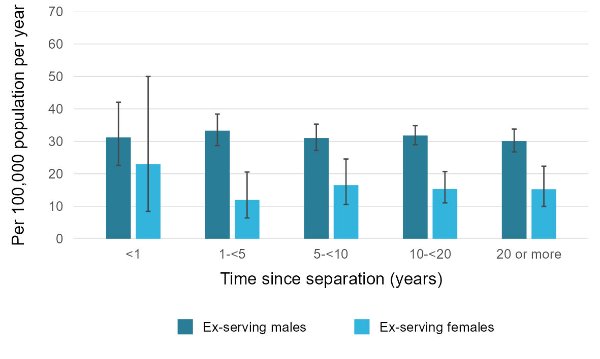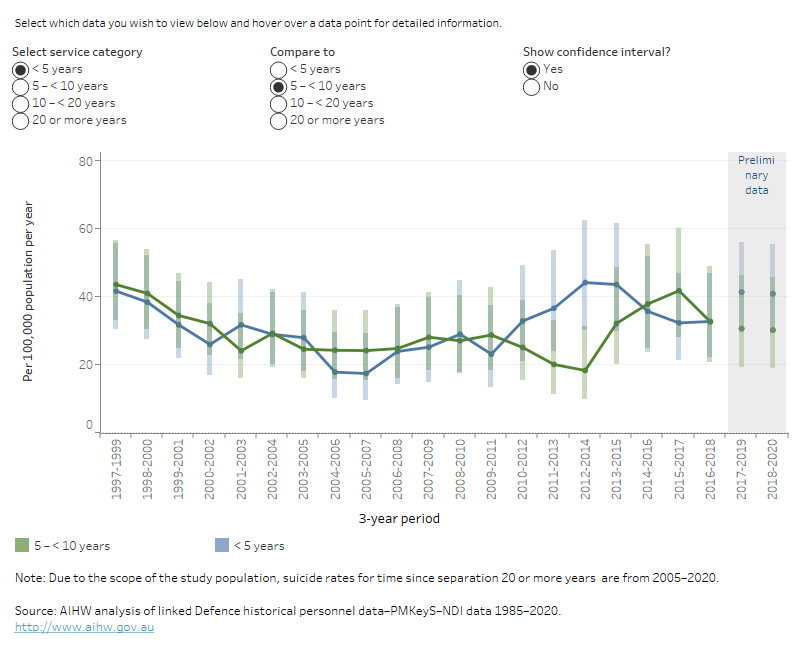Suicides by time since separation
For ex-serving members who have died by suicide, time since separation is the time between separation from the ADF1 and date of death. In this report, time since separation is presented in five groups (ranging from less than 1 year to more than 20 years).
The proportions of the ex-serving cohort that fall into each time since separation category are:
- Around half (50.8% of males and 52.2% of females) separated from the ADF 20 or more years prior.
- Just under one quarter (23.1% of males and 23.2% of females) separated from the ADF between 10 and 20 years ago.
- Just over 1 in 10 (11.1% for males and 10.4% of females) separated from the ADF between 5 and 10 years ago.
- For males 12.8%, and for females 11.9% separated from the ADF between 1 and 5 years ago.
- Around 2.2% of males and 2.3% of females separated less than 1 year ago.
Table 9 below gives the suicide rates corresponding to these categories.
| Number of years since separation(a) | Ex-serving males: Suicide rate per 100,000 population per year | Ex-serving females: Suicide rate per 100,000 population per year |
|---|---|---|
| <1 | 31.2 | 23.0 |
| 1-<5 | 33.3 | 12.0 |
| 5-<10 | 31.1 | 16.5 |
| 10-<20 | 31.8 | 15.3 |
| 20 or more(b) | 30.1 | 15.3 |
Notes:
- The period between separation date and extract date (31 December 2019) for those alive at the extract date. The period between separation date and death for ex-serving members who have died.
- Due to the study population, suicide rates for time since separation 20 or more are from 2005–2020.
Source: AIHW analysis of linked Defence historical personnel data–PMKeyS–NDI data 1985–2020.
The average time since separation was close to 19 years, and was the same for males and females. The maximum length of time since separation observed in this study was 36 years.
The rates of suicide were similar regardless of time since separation for both ex-serving males and females, as demonstrated below in Figure 14.
Figure 14: Suicide rate by time since separation, ex-serving males and females, 1997–2020

Source: AIHW analysis of linked Defence historical personnel data–PMKeyS–NDI data 1985–2020.
Time since separation over time for ex-serving males
Suicide rates over time for ex-serving males by time since separation are presented in the interactive graph below. Note that due to small numbers of suicide deaths with less than one year since separation data are aggregated and presented for less than five years since separation.
Due to the small number of suicide deaths among ex-serving females, suicide rates over time are not reported.
Although there has been some small variation in the suicide rates for individual groups over time, these variations were not significant.
The interactive graph below (Figure 15) presents the suicide rates for ex-serving males in each of the time since separation groups for all 3-year periods from 1997-1999 to 2018-2020.
Figure 15: Rate of suicide for ex-serving males by time since separation, 1997–1999 to 2018–2020
This time series line graph shows the weighted average suicide rate per 100,000 population per year of ex-serving males by time since separation over time by 3-year periods from 1997 to 1999, to 2018 to 2020.

Note: The confidence intervals in this figure can be used to determine whether there is a statistically significant difference between the suicide rates calculated for the ADF between different 3-year periods. However, they cannot be used to determine whether there is a statistically significant difference between rates calculated for the ADF population for overlapping 3-year time periods (for example 2002–2004 and 2003–2005).
Data underlying this graph are available in supplementary table S6.7 See Data for a link to the tables.
Please note, data for more recent years are subject to change; see the Technical notes for further detail.
- Note that the separation point used in this study reflects full separation from the ADF – that is, when a member is no longer in permanent or reserve service.
If you need help or support, please contact:
- Open Arms - Veterans and Families Counselling 1800 011 046
- Open Arms Suicide Intervention page
- Defence All-hours Support Line (ASL) 1800 628 036
- Defence Member and Family Helpline 1800 624 608
- Defence Chaplaincy Support 1300 333 362
- ADF Mental Health Services
- Lifeline 13 11 14
- Suicide Call Back Service 1300 659 467
- Beyond Blue Support Service 1300 22 4636
For information on support provided by DVA, see:


